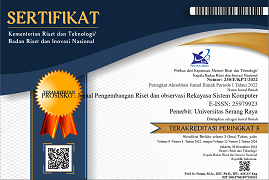ESTIMASI LOKASI OBJEK BERBASIS WIFI PADA GEDUNG BERTINGKAT MENGGUNAKAN METODE NAÃVE BAYES
Abstract
WiFi merupakan Wireless LAN yang disertifikasi standar IEEE 802.11. WLAN berbasis IEEE 802.11 merupakan teknologi yang telah banyak diaplikasikan di berbagai tempat, mulai dari kampus hingga gedung-gedung perkantoran. Keberadaan teknologi ini dapat diaplikasikan untuk estimasi lokasi objek dalam gedung tersebut dengan memanfaatkan RSS (Received Signal Strength) yang diperoleh dari AP yang telah tersedia. Penelitian ini difokuskan pada pemanfaatan RSS yang berasal dari AP yang terpasang di dalam dan di sekitar gedung JTETI UGM tanpa melakukan pemasangan AP tambahan. Pengukuran RSS fingerprint dilakukan dengan empat arah yang berbeda yaitu Utara, Timur, Selatan dan Barat menggunakan grid-area 1m x 1m and 2m x 2m. Estimasi lokasi objek ditentukan menggunakan algoritma Naïve Bayes dan k-Nearest Neighbor (k-NN) sebagai pembanding. Metode Naïve Bayes menggunakan grid-area 1m x 1m memberikan hasil estimasi lokasi dengan akurasi tertinggi. Orientasi pengukuran yang berbeda memberikan hasil estimasi lokasi yang berbeda. Selain itu sistem ini juga mampu menentukan di lantai berapa posisi objek berada.References
A. Kupper, 2005. Location Based Services: Fundamentals and Operations, John Wiley & Sons.
J. Caffery, 2000. Wireless Location in CDMA Cellular Radio Systems, Kluwer Academic Publishers.
K. Kamol and K. Prashant, 2004. Properties of Indoor Received Signal Strength for WLAN Location Fingerprinting, in: Proceedings of the First Annual International Conference on Mobile and Ubiquitous Systems: Networking and Service.
N. Sirola, 2007. “Mathematical methods for personal positioning and navigation,†Ph.D. dissertation, Tampere University of Technology.
P. Castro, P. Chiu, T. Kremenek and R. Muntz, 2001. A probabilistic room location service for wireless networked environments, Ubiquitous Computing.
A. Gelb (Ed.), 1974. Applied Optimal Estimation, MIT Press.
P. Enge and P. Misra, 1999. “Special issue on GPS: The Global Positioning System,†Proceedings of the IEEE, pp.3-172, January.
R. Want, A. Hopper, V. Falcao and J. Gibbons, 1992. “ The Active Badge Location System,†ACM Transactions on Information Systems, Vol. 10, no.1, pp. 91-102, January 1992.
R. Want, B. Schilit, D.A. Norman, D. Goldberg, K. Petersen, J. Ellis and M. Weiser,†An Overview of the ParcTab Ubiquitos Computing Experiment,†IEEE Personal Communications Magazines, vol. 2, issue 6, pp.28-43, Dec 1995
N.B. Priyantha, A. Chakraborty and H. Balakrishnan, The cricket location-support system, in: Proceedings of the 6th ACM MobiCom, Boston, MA pp. 32–43, 2000.
J. A. Ward, A. Jones, A. Hopper, “A New Location Technique for the Active Office,†IEEE Personal Communication Magazine, vol.4 no.5 pp. 42-47, 1997
D. Fox, J. Hightowerand, L. Liao, D. Schulz, and G. Borriello, Bayesian filtering for location estimation, in: Proceeding of IEEE Pervasive Computing, vol. 02, no. 3, pp. 24–33, 2003M. Hassan-Ali and K. Pahlavan, Site-specific wideband and narrowband modeling for indoor radio channel using ray-tracing, in: Proceedings of the PMIRC’98, Boston, MA, 1998.
H. Liu, H. Darabi, P. Banerjee, and J. Liu, Survey of wireless indoor positioning techniques and systems, in: Proceedings of IEEE Transaction on Systems, Man, and Cybernetics, vol. 37, no. 6, pp. 1067–1077, November 2007.
Aalto, N. Gothlin, J. Korhonen and T. Ojala, “Bluetooth and WAP Push based Location Aware Mobile Advertising System,†in MobiSYS: Proceeding of the 2nd International Conference on Mobile Systems Application and Services, pp. 49-58. ACM Press, 2004
C.L. Chan. Eddie, George Baciu, S.C. Mak, Using Wi-Fi Signal Strength to Localize in Wireless Sensor Networks, in: Proceedings of International Conference on Communications and Mobile Computing, vol 978-0-7695-3501-2/09, 2009.
G. V. Z`aruba, M. Huber, F. A. Kamangar, I. Chlamtac, Indoor location tracking using RSSI readings from a single Wi-Fi access point, in: Proceedings of Wireless Network (2007) 13:221–235, 2007.
P. Bahl and V.N. Padmanabhan, RADAR: An in-building RF-based user location and tracking system, in: Proceedings of IEEE Infocom 2000, Tel Aviv, Israel, Vol.2, pp.775–784, 2000.
K. J. Krizmant, T. E. Biedkatt, and T. S. Rappaportt, Wireless position location: Fundamentals, implementation strategies, and sources of error, in: Proceedings of the VTC, vol. 2, May 1997.
A. Bensky, Wireless Positioning: Technologies and Application, ser. GNSS technology and application series. Artech House Publishers, 2008.
Chrtman, F. dan Roeder, K. 2003. Wi-Fi Handbook: Building 802.11b Wireless Networks, McGraw-Hill.
Robles. Jorge J., Martin Deicke, and Ralf Lehnert, 3D fingerprint-based Localization for Wireless Sensor Networks, in: Proceedings of IEEE, 978-1-4244-7157-7/10/2010, 2010.


















